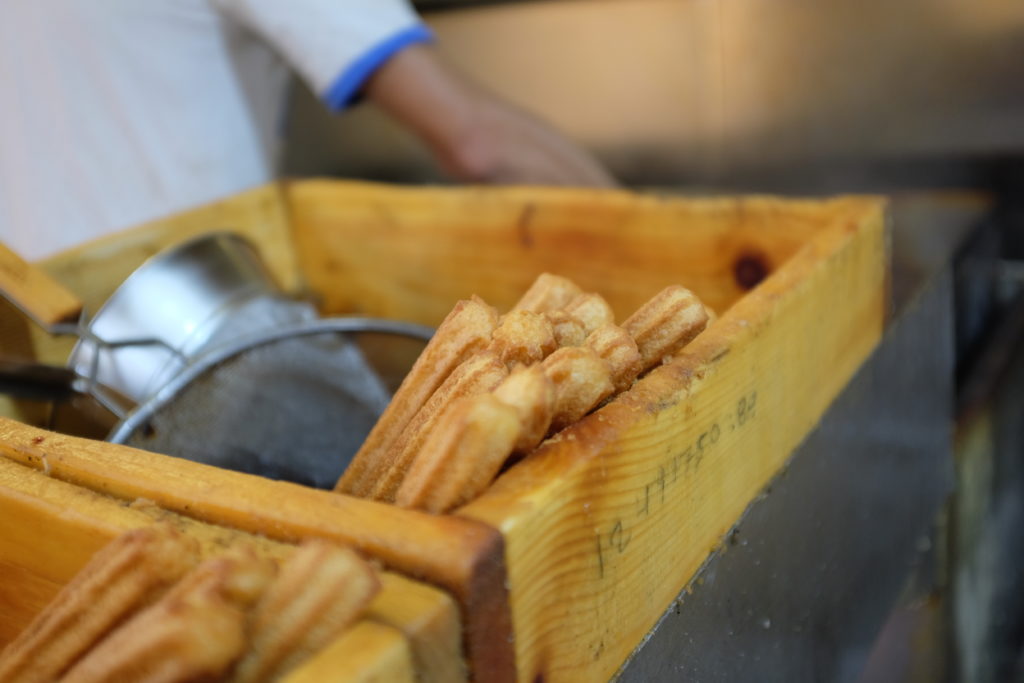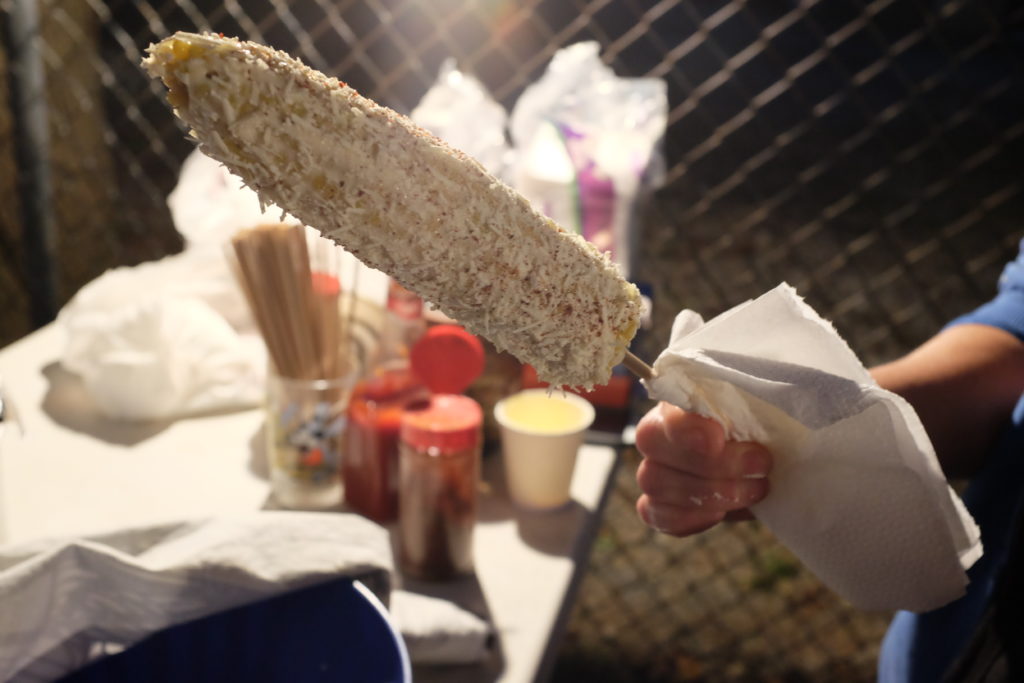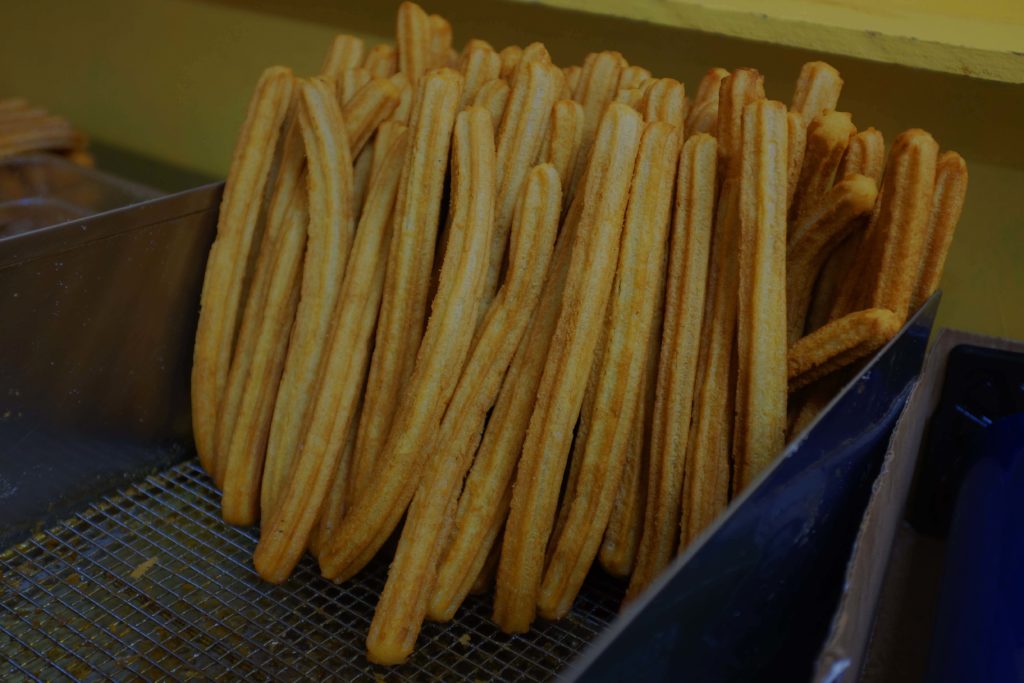
Alex’s Churros Kitchen. Photo: Rachael Bongiorno
In a narrow alley just behind a busy Queens street, Alex’s kitchen makes more than 4,000 churros each day for street vendors to sell across New York City. From 3:00 a.m., hours before nearby shop owners unlock their front gates, the kitchen fills with the sound of churro batter beating against the sides of large industrial mixers.
The kneaded dough is shaped by a long dispenser that drops it into sizzling hot oil. The churros – long, striated donuts – are finished with a sprinkling of sugar and cinnamon and stacked high on baking trays by Alex’s wife.
Alex [not his real name] moves quickly, grabbing dough from the mixer before hurrying to the fryer so the churros are ready when his vendors come to pick up their orders. Time is of the essence, he can’t risk losing any more buyers.
It took Alex 14 years to build up his wholesale churro business, but it only took one week, following the election of Donald Trump, for him to lose half of his customers.
“My business has been affected greatly this year. My vendors are scared they will get caught and deported,” Alex says, speaking in Spanish. “They have left and started working other types of jobs now.”
Within the first 100 days of Trump’s presidency, Immigration and Customs Enforcement (ICE) arrested more than 41,000 people — an increase of 37.6 percent from the previous year. The surge in ICE arrests across the nation this year, coupled with the anti-immigrant policies of the new administration, have spurred a noticeable drop in vendors selling on New York City streets as well as a decline in the number of street vendor customers.
“I remember the first few months of [Trump’s presidency] there was no one on the streets in Queens. There were not a lot of vendors out or people walking to be the customers of vendors,” says Sean Basinski, the director of The Street Vendor Project, a non-profit organization that provides legal representation and advocacy to street vendors in the city.
There’s no statistical information on the economic impact the Trump administration’s immigration policies have had on street vendors, many of whom are undocumented immigrants. But in the Queens neighborhoods of Jackson Heights, Corona, and Jamaica, where selling food and other items on the street is common practice, some vendors say they have lost a significant portion of their income.
“There was a period that there were a lot of rumors that ICE was on Roosevelt Avenue (a busy commercial street in Jackson Heights) — that there was an ICE van there by the subway,” Basinski says. “I don’t think that was true, but people thought they were going to get picked up.”
Last year was a turning point for Alex’s churreria. He had finally earned enough income to afford a larger facility with industrial equipment and an additional baker. But with his income now cut in half, he has been forced to return to the streets to sell churros. On Sundays he drives with his wife to suburban Westchester and Pennsylvania to sell his churros to churches with large Latino congregations.
Alex came to New York 17 years ago from Cuenca, Ecuador, at the age of 32. A few weeks after arriving, he got a job at a car wash, where he made $30 a day. He recalls never having that much money in his hands before.
Read more in our online magazine Immigrants, Food and America’s Culture Wars
But after watching the quick exchange of money by a young churro seller at a train station one night, he decided to become a churro vendor himself. When he realized he could make more money supplying other vendors as a churro baker, Alex convinced a Mexican baker to teach him the craft. He then began building a network of vendors to buy his churros.
In Queens neighborhoods such as Jackson Heights and Corona, where 57.5% of the total population is foreign-born and over 100 languages are spoken, street vending provides an opportunity for many immigrants to make a living. But for some, that’s become increasingly difficult.
On a warm fall afternoon, women are lined up on Roosevelt Ave. selling cuts of roasted pork shoulder wrapped in tortillas, shish kebabs cooked on aluminum grills hovering over shopping carts, and $1 tamales kept warm in beverage coolers.
Glady, a street vendor who sells shish kebabs, says she has lost half her income this year. Even on this fine day, she has had few customers.
“I haven’t even made fifty dollars,” she says in Spanish, as she heats up the grill. “The change in president has caused people to not want to spend their money because they might arrest us one day. A lot of my friends have left.”
Ruth, a street vendor working across from Glady, waits for familiar faces to buy her chicharron (pork cracklings), braised pork, and beef cuts stacked up high over a hot flat grill. She believes customers aren’t buying because they’re also saving up in case they or members of their family are deported.
“A lot of people don’t come like before because they don’t want to risk. People are avoiding a lot of cost because if something happens to them, at least they have some savings,” Ruth says, in Spanish. “They don’t have that liberty to buy like before we had this new president.”
There are an estimated 20,000 street vendors in New York City. But in 1981 the city capped the number of street vendor permits it issues at around 5,000. This means that roughly 80% of vendors are unable to operate their food businesses legally.
Matthew Shapiro, senior attorney at The Street Vendor Project, says many immigrants are unable to find traditional jobs. Street vending is an easily-accessible line of work that allows them to make a living. But unlicensed vendors run the risk of being ticketed or even arrested by local law enforcement. In the current political climate, those risks are magnified for undocumented vendors who peddle without permits. Any contact undocumented immigrants have with the criminal justice system is widely seen as raising their vulnerability to being detained by ICE and potentially deported.
“Since we’ve had such a hard line immigration stance coming out of the federal government, this puts them at further risk,” Shapiro says. “So if they are out there selling and breaking the law, that could result in higher-level immigration consequences.”
For example, some immigration attorneys express concern over the increase in ICE arrests in and around courthouses. According to the Immigrant Defense Project, these arrests in New York increased by 900 percent in 2017.
While many vendors continue to struggle to make a living on the street, others have found new ways to reduce the risk of being arrested or detained while still maintaining their business.
Like other street vendors, Maria [not her real name] has seen a drop in income this year. In the past she sold lunches from a cart on the street without a permit. But for the past couple of years this mother of three sells food only from her home.
“If I keep going to court [to pay tickets for vending], they could deport me,” Maria says, in Spanish.

Maria holds a freshly garnished elote. Photo: Rachael Bongiorno
Maria has good reason to fear deportation. Born and raised in El Salvador, she settled in Nassau County, Long Island, 15 years ago in a town with a large immigrant population. She began selling food throughout the neighborhood in order to sustain her family.
Then one night, ICE knocked on her door at 2:00 a.m. and arrested her partner. The agents entered their bedroom and awakened them from their sleep. At the time, Maria was pregnant and she had no idea how she could support her family after the father of her children was deported.
“You can imagine how I feel when I see ICE cars [even now],” she says. “I stay paralyzed.”
In the early evening, a light bulb attached to an extension cord illuminates a stock pot of boiled corn (elote) and atole (a corn beverage infused with cinnamon, sugar and milk) on a folding table in Maria’s driveway. As curious neighbors stop by for a warm beverage, she scoops the steaming atole into styrofoam cups, and slathers cobs of corn with mayonnaise, crumbly white cheese, and hot sauce.
Although Maria once made $500 a week as a street vendor, she now settles for the $100 she makes from selling outside of her garage. Her new approach avoids the fines she once received, and she says she now sleeps with the peace of mind that she and her daughters are safe.
The director of the Street Vendor Project, Sean Basinski says that a large decline in street vendors and their income could have significant cultural and economic implications for the city.
“Who could imagine New York City without street vendors?” Basinski asks. “If we don’t have the streets as a home for small businesses to start and to thrive and grow, eventually that’s going to affect the economy of New York City.”
A 2012 study conducted by the Institute for Justice, showed that street vendors contributed 17,960 jobs, $71.2 million in taxes, and $192.3 million in wages to the city’s economy that year.
For Alex, who had dreams of expanding his churros business nationally, his plans have been put on hold. If more of his vendors quit selling churros, he worries that next year will be the last for his churreria.
“I will have to close my business and go back to selling churros by myself,” he says. “Only the bravest will sell next year.”
Katherine Hernandez is Feet in 2 Worlds’ Food Reporting Fellow. The fellowship is sponsored by the International Association of Culinary Professionals and The Culinary Trust, whose mission is to give culinary professionals the tools and opportunities to understand and act on critical issues in the world of food. Together, Feet in 2 Worlds and The Culinary Trust help emerging voices tell important food stories from the perspective of new Americans.
Fi2W is supported by the David and Katherine Moore Family Foundation, the Ralph E. Odgen Foundation, The J.M. Kaplan Fund, an anonymous donor and readers like you.




